Recent Storm Damage Posts
Key Distinctions Between Storm Damage and Flood Damage
7/19/2024 (Permalink)
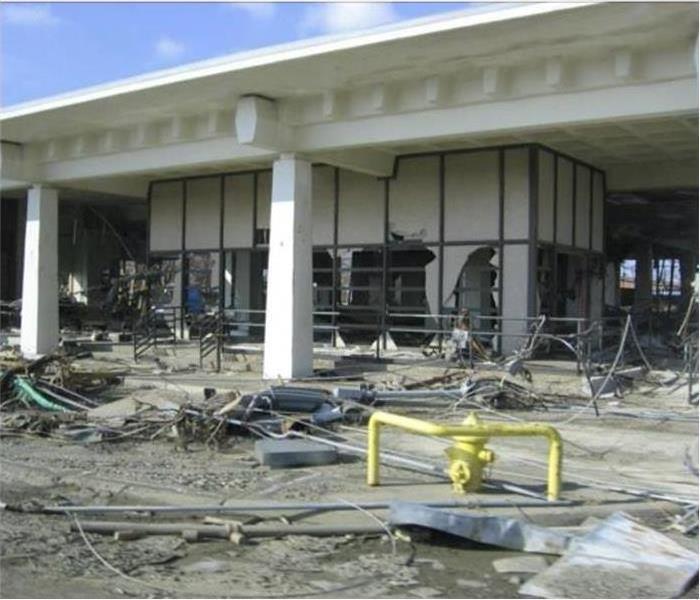 Storm damage in Pflugerville, TX
Storm damage in Pflugerville, TX
Storm Damage vs Flood Damage
At first glance, it would seem that flood damage and damage from a storm would be pretty similar. In reality, though, the two have critical differences. A flood usually occurs from the ground up, often the result of rising waters from streams and rivers and typically entering a building in Pflugerville, TX, by way of a the foundation. On the other hand, water from storms more often than not comes down from above through the roof system. Storm damage also includes harm to the building caused by powerful winds, large hail or heavy snows. Either type of damage can be devastating to a company, but the restoration process for each includes important differences.
Insurance
Flood damage is not typically covered by a company's general insurance policy, while damage from a storm is usually covered. Therefore, a company that is located in an area at risk for flooding should carry flood insurance. The most common and affordable flood insurance is available through the National Flood Insurance Program and has the following features:
- Covers damages caused by a flood
- Is administered by FEMA
- Is voluntary in most circumstances
- Is purchased through licensed insurance agents
- Typically has a 30-day waiting period
Damage from a storm is typically covered under a company's general policy. It usually covers damage caused by the storm and expenses for restoration.
Cleanup
A company faced with any type of water damage should consult with a reputable storm mitigation franchise for assistance with restoration. In the case of flood damage, though, the cleanup is complicated with the presence of contaminated water. This dirty water coming into the building could contain chemicals, pathogens, microbes and other potentially dangerous substances. This requires cleanup and restoration by an experienced team of trained technicians that wear PPE and take other safety precautions. The water from a storm coming in through the roof is seldom considered contaminated and can be addressed through a standard restoration process.
4 Ways to Prepare Your Business for a Winter Storm
1/3/2024 (Permalink)
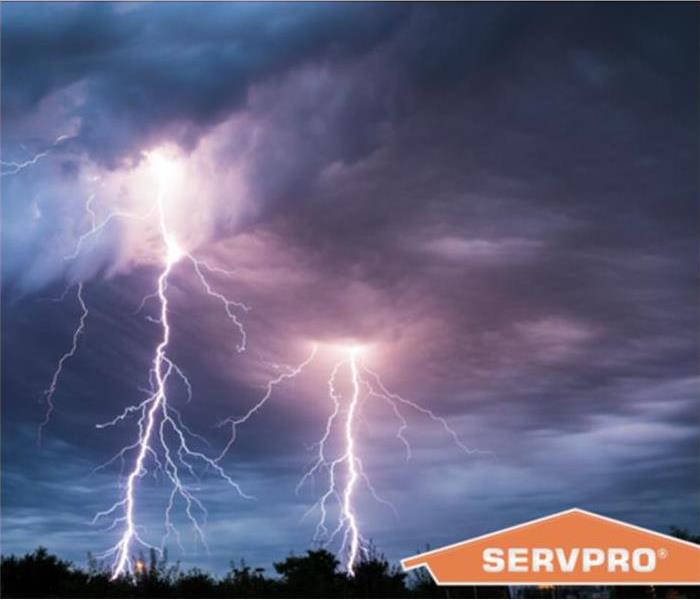 If your building is damaged during a winter storm, then a cleanup and repair company can help.
If your building is damaged during a winter storm, then a cleanup and repair company can help.
When you are expecting severe weather in Austin, TX, you should take steps to be prepared. A winter storm can cause a lot of damage to your building, so use the following tips to minimize its effect on your business.
1. Stay Informed
One of the most important things you can do to prevent storm damage is to keep updated with any new information. The weather can be unpredictable and may sometimes change quickly. Watch the news to identify any changes in the situation so you can alter your plans if necessary.
2. Keep the Building Warm
During a storm, the temperature may drop. If it gets too low, you could end up with frozen pipes which could cause a pipe break. Water may flood your building and cause damage to its structure as well as the items inside. In order to prevent this, make sure to keep the heat on even after you leave the building. You may want to insulate any exposed pipes and leave doors open to allow heat to circulate as well.
3. Check Doors and Windows
The areas around doors and windows often deteriorate more quickly than other places in the building. If these are not in good shape, they won’t be able to keep out moisture properly. Make sure that all windows and doors are sealing and well-insulated.
4. Inspect the Exterior
During a winter storm, damage to the exterior of the building can become worse. Cracks in the walls can let water in and can contribute to the growth of mold. Loose roof tiles can be blown off and leave areas exposed. Check everything carefully and have repairs done if necessary.
If your building is damaged during a winter storm, then a cleanup and repair company can help. They can remove any water that has entered the building, perform mitigation and make repairs. If any belongings have been damaged, they can salvage many of these as well.
Protect Your Business During a Thunderstorm
8/21/2023 (Permalink)
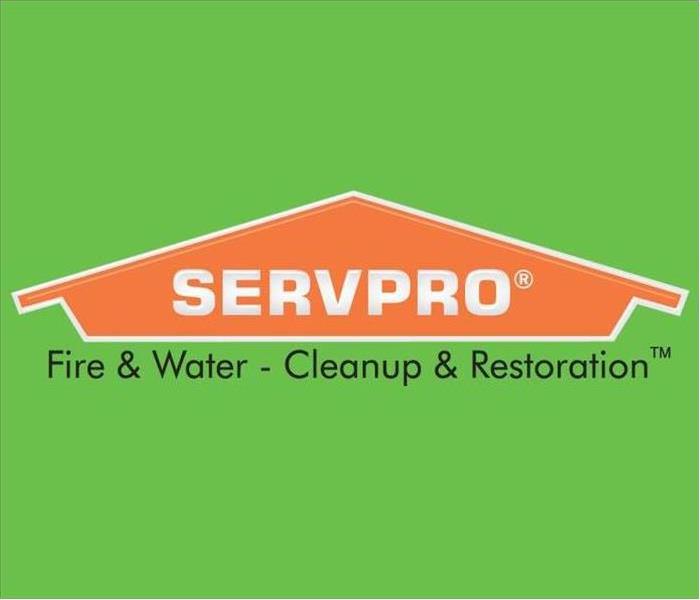 Severe rainstorms are no joke and many buildings have been devastated because they neglected to prepare properly.
Severe rainstorms are no joke and many buildings have been devastated because they neglected to prepare properly.
Thunderstorms are tricky because of how drastically they can vary in terms of severity. Mild thunderstorms are nothing more than a nuisance, while severe storms can wreck havoc on your commercial building. It's important to ensure that you're prepared for any type of rain storm, just in case. Follow these tips to keep your building in Austin, TX, safe.
Before the Storm
Preparation is key, no matter which type of emergency you're dealing with. Use the following safety checklist to see whether your building is prepared to take on high winds and other dangerous weather:
You have an emergency supply kit fully stocked and easily accessible.
You and your employees have learned and practiced proper emergency protocol.
You have designated a safe place in your building to shelter during the storm.
You have consulted your local fire department regarding proper lightning rod installation.
You have ensured that the trees and shrubbery surrounding your building are properly trimmed.
During the Storm
Assuming you have abided by the preceding and your building is adequately prepared to take on a severe rain storm, staying safe and calm during the thunderstorm should be a breeze. Simply make sure that everyone in the building stays sheltered in place for the duration of the storm. Stay tuned in to local emergency broadcasts for updates. Secure all doors and windows and shelter away from any glass paneling. Avoid using any plumbing or electrical equipment for the duration of the storm. Even if you think the storm has passed, you should still wait to leave until at least 30 minutes after the last thunderclap, or until your emergency broadcast radio gives the all clear signal.
Severe rainstorms are no joke and many buildings have been devastated because they neglected to prepare properly. Follow the above tips to help avoid letting your commercial building become another statistic. If your building does fall victim to storm damage, make sure to contact storm remediation experts as soon as you can.
Flood Readiness
7/18/2023 (Permalink)
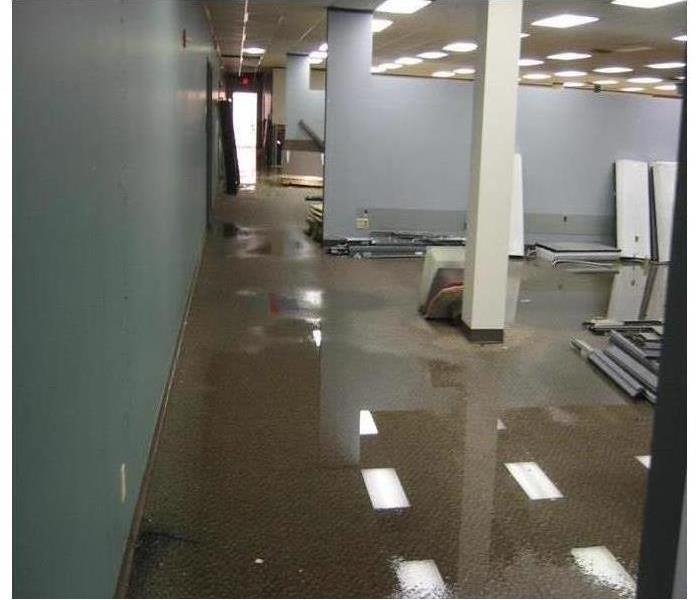 Commercial flooding in Pflugerville, TX
Commercial flooding in Pflugerville, TX
Flooding to your Pflugerville, TX business can be a very stressful event. Unfortunately, many insurance policies do not cover floods. A separate flood policy must be purchased. It is important to know the difference between flood damage and other types of storm damage so that you can make sure your commercial property is adequately protected.
Flood Definition
Many property owners think of floods as any unwanted standing water, whether from a broken appliance or a storm surge. However, according to FEMA (Federal Emergency Management Agency), to be characterized as a flood, the water damage must affect at least two acres or two separate properties and be caused by one of the following:
- Overflow of rivers, lakes and other inland bodies of water (whether due to erosion or excess rainfall)
- Tidal overflow
- Mudflow
- Surface water accumulation or runoff
Water damage caused by other means, such as a roof leak during a rainstorm, is not considered flood damage. In such cases, the claim should be filed with the standard property owner's insurance rather than on the flood policy.
Flood Mitigation
Although floods can cause serious problems, it is possible to minimize the damage to your business by taking some precautions. Use sandbags or inflatable dams to form a barrier around your building. You can fortify the barrier by securing windows and doors with plastic tarps. Move furniture, electronics and other important items to a safe location. This could be the second floor of your building or an off-site location. Keep electronic copies of important documents such as insurance policies. Make sure to have emergency supplies on hand and an emergency plan in place before flooding begins. When the water stops rising and it is safe to do so, begin drying out the property to prevent mold growth.
Unfortunately, it is impossible to prevent flood damage. If your commercial building suffers flooding, you may decide to contact a certified restoration company to help you get your business back to normal quickly and safely.
How To Tell If Your Roof Has Storm Damage
12/12/2022 (Permalink)
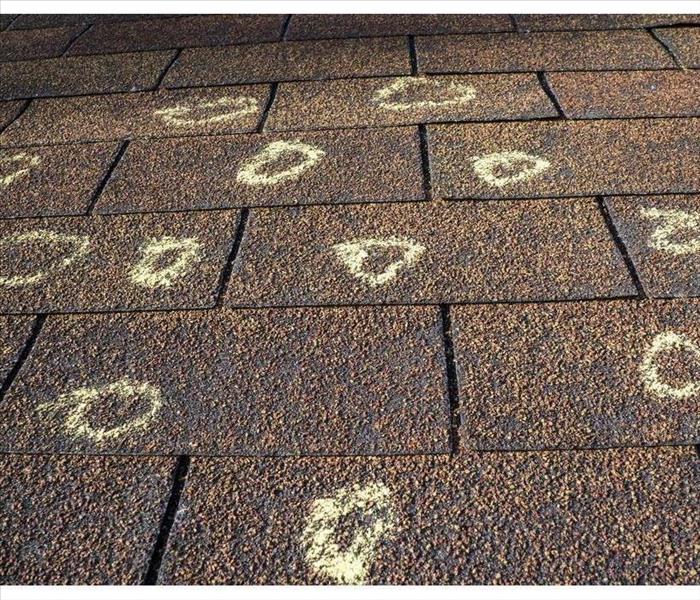 Hail damage to roof
Hail damage to roof
Signs of Storm Damage
Storms can have devastating effects on your home, especially if you don't take precautions. When you hear about storms on the news and see the damage they've caused, it's easy to forget that you live in an area where these things are possible. However, if your roof has been damaged by a storm or flood, it's important that you know how to tell—and then fix—the problem as soon as possible. Here are some signs of storm damage:
Storms can do a lot of damage to your home, including your roof.
The most common cause of storm-related damage is hail, which is small chunks of ice that fall from thunderstorms and can pierce cars and roofs. Hail often goes unnoticed until it melts, leaving behind dents in the roof that need repair work by an experienced contractor.
Other types of storm damage include wind, lightning and flooding - all of which can affect your home's exterior as well as its interior insulation.
Hail damage
Depending on how large the hail is, it can cause dents and cracks in your roof. This means that water can leak into your home through these holes. Hail also causes rapid deterioration of shingles, which will lead to leaks that could cost you thousands of dollars over time.
Hail damage to your roof can be detrimental to more than just the look of your house; it could also cause mold growth inside your walls or ceiling as well as rot if left untreated for too long! If not addressed promptly by a professional contractor, hail damage has been known to lead to other issues such as pooling water near chimneys or vents where rainwater is likely to collect during storms -- thus increasing the likelihood of ice dams forming on roofs during winter months when temperatures drop below freezing.
Wind damage
You can tell if a roof has been damaged by storm damage if you see the following signs:
- Loose shingles and tiles. If you see any of these, it's time to call a roofing contractor.
- Dents in the surface of your roof. This is also an indication that you need to hire a professional.
- Missing or torn shingles and tiles, which may be caused by flying debris during a storm or high winds.
Lightning strikes
If your roof is hit by lightning, you may have to deal with a fire. This could happen even if the lightning strike itself doesn't burn through the roof (though this is possible). If the electricity travels through or into your house and causes an electrical fire, your entire home will be damaged significantly as well.
Lightning strikes can cause leaks in your roofing materials and damage them beyond repair. The water damage from these leaks can lead to mold growth inside of your home, which can cause significant property damage.
Storms can do a lot of damage to your home, including your roof. It's important to take notice of this and make sure you have the right repairs done. Routine maintenance is the best way to avoid roof damage. If your home or business as suffered from any damage, don’t hesitate and give our SERVPRO of Pflugerville team a call today!
How To Treat Mold Damage After a Flood
8/23/2022 (Permalink)
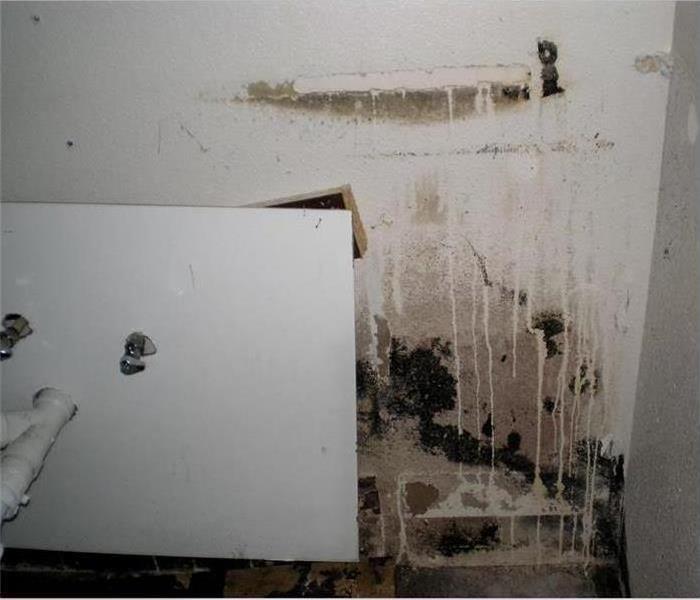 Commercial mold damage in Cele, TX.
Commercial mold damage in Cele, TX.
How To Treat Mold Damage After a Flood
If your business in Cele,TX, has been caught in a flood, it's important to quickly check for mold growth. You don't want standing water to linger and cause further damage to your flooring or any other part of your structure. Mold can grow and spread in as quickly as 24 to 48 hours, so it is key to act as soon as possible before further problems occur.
Examine the Area Damaged
Look closely at the area of your floor that flooded. This might be the whole floor, a certain area, or just one level, such as a basement within your business. Once you have an idea of what areas need to be looked at, seek help from professional emergency restoration services rather than attempting to tackle the problem on your own.
Understand Different Treatments Used
There are a variety of treatments that can be used to prevent the spread of bacteria depending on the type of mold growth that has developed. These can include:
- Abrasive cleaning
- Foam cleaning
- Immersion cleaning
- Wet cleaning
If there is growth that is difficult to remove, abrasive cleaning might be the best method. Foam is typically used for treating upholstery, while wet cleaning is helpful for heavy residue left behind. Your floor might need one or more of these methods.
Get the Area Treated Quickly
Once you suspect mold damage has happened as the result of a flood, it's necessary to get it taken care of as soon as possible. The restoration company can help you understand where you need to have work performed and what the extent of your damage is. You can determine if you'll need to temporarily close your business. Even if you do, you can feel confident knowing the damage has been treated.
While mold growth can occur quickly, you can mitigate the damage by getting it cleaned up as soon as possible. With proper treatment, you can ensure it does not cause further problems.
3 Landscaping Features That Help Prevent Flooding
7/20/2022 (Permalink)
 Keep floodwater out by leveling your yard
Keep floodwater out by leveling your yard
Three Landscaping Features to Reduce Flooding
A rain storm can be a welcomed sight, but a flooded yard is not. To keep your lawn from becoming a swamp, here are three landscaping features to help you disperse outside flooding.
A Driveway Built for Drainage
The two most commonly used materials for driveways are concrete and asphalt. These pavements don’t allow water to seep into the ground. This creates a lot of runoff with nowhere to go. Here are some ideas for getting good rain drainage when installing a driveway:
Channels on sides of concrete/asphalt driveways to catch and redirect runoff
Covered drains in-between concrete slabs to let water slip through and absorb into the ground
Paving stones with spacing for water seepage as a pleasingly aesthetic alternative
Gravel as a classic, budget-friendly option
By making wise design choices, you can build a driveway that helps prevent outside flooding.
A Leveled Yard
Keep floodwater out by leveling your yard. Low areas in yards are where flooding happens most. Fill them in with topsoil to keep water from pooling. The high points of your yard should be around your home and then gradually slope away, keeping storm runoff from your foundation. Low points near the house can lead to water in your basement. If this happens, call your local storm damage experts and ask for future prevention advice during your assessment.
A Strategically Placed Swale
A swale is any type of “ditch” that redirects rainwater away from your home. It is often integrated into lawns as a water feature. A swale does not only move rainwater but slows it down and allows it to seep into the ground. Planting shrubs along its edges and laying stones at the bottom of a swale helps it slow and disperse water even more.
Making smart design decisions and preparing for the upcoming storm season in Pflugerville, TX, will help you prevent outside flooding and enjoy your lawn, even after heavy rain.
4 Sources of Leaks During a Rainstorm
4/25/2022 (Permalink)
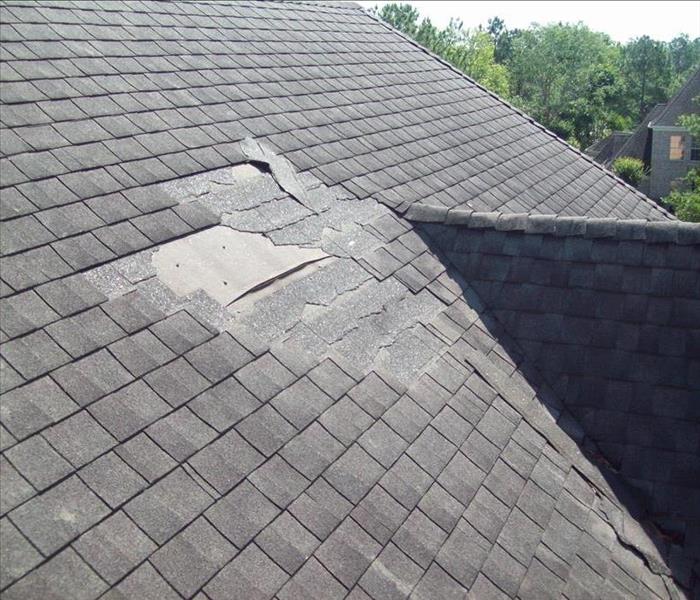 If there are missing shingles on flat roof water can easily drip into the building envelope.
If there are missing shingles on flat roof water can easily drip into the building envelope.
What Is The Source Of The Leak In Your Building's Roof?
You may have assumed your commercial building in Pflugerville, TX, was in good condition, only to come to work the day after a storm to find extensive rain damage: soggy paperwork, short-circuited computers, and a developing patch of black mold on one wall. Along with calling in professional water damage mitigation, you are obviously concerned with stopping this problem from happening again. What is the source of the leak in your building's roof?
1. Damaged Roofing
The problem may be an obvious one. If there are missing shingles or a visible break in a flat roof, water can easily drip into the building envelope. High winds or blowing debris can do significant damage in a major storm, making a hole leading to a big leak. However, if there is no clear damage, look elsewhere for the problem.
2. Gaps in the Flashing
Flashing refers to thin strips placed around structures on a roof to prevent leaks. Usually made of aluminum or galvanized steel, the flashing around chimneys, vents and skylights stop water on the roof from getting through. If the flashing is installed incorrectly or is damaged in a storm, rain damage can occur from water seeping through gaps or cracks.
3. Wind-Driven Rain
Even if the roof and its flashing are entirely intact, rain can still get through some kinds of roofing. High winds can drive rain sideways, causing it to collect under shingles or in improperly arranged vents and cause rot and leaks.
4. Other Water Sources
If you have had your roof inspected and there are no problems with the roofing or flashing but you are still finding puddles inside your building, it can be a good idea to look for another source besides a rainstorm outside. A cracked or leaking pipe in a wall or ceiling or an overflowing toilet can cause significant water damage regardless of how dry the weather is.
After experiencing rain damage, be sure to inspect your commercial building carefully and make the repairs necessary to prevent issues in the next storm.
5 Ways To Protect Your Business from Flood Damage
4/6/2022 (Permalink)
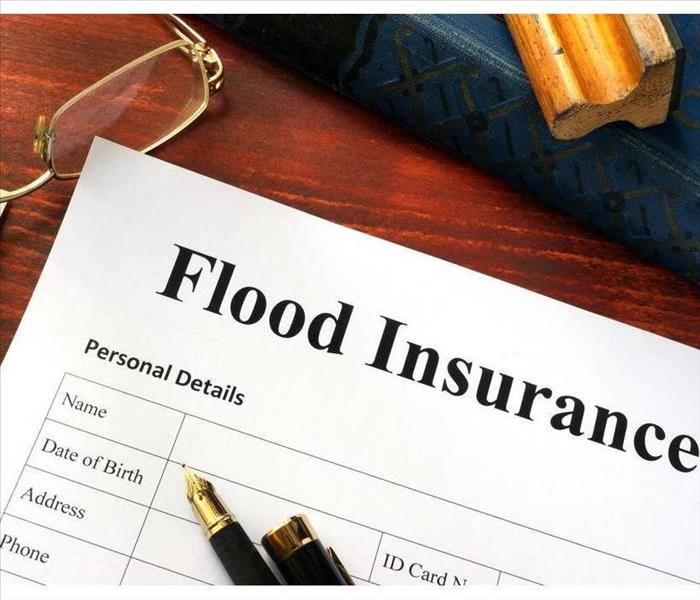 Buy flood insurance.
Buy flood insurance.
Five Ways to Prevent Flood Damage in Your Business
When you own a business, it's important to be prepared for emergencies of all types. If you know that you live in a flood-prone area such as in New Sweden, TX, then there are some proactive steps you can take to prevent flood damage to your building.
1. Buy Flood Insurance
When you purchased your building, you were informed of the flood risk to your property. If any significant portion of your building is below the base flood elevation, it's a good idea to have flood insurance. Even if flooding isn't common in your area, it can still happen during a stronger than normal storm.
2. Be Careful with Storage
If you do have a basement below your base flood elevation, be very careful about what you store there. If there's any chance of storm damage ruining important documentation or products, find a different place to store those items.
3. Raise Electrical
From your actual electrical panels, sockets, and wiring to your HVAC system, ensure that these aren't installed in areas susceptible to flood damage. Not only does this prevent damage to those electrical components, but it's also safer for you and your staff. After a flood, work with a water damage restoration company to assess the safety of your building before returning to collect your belongings.
4. Landscape Wisely
Does your landscaper know how to prevent flooding by using native plants? Plants that are native to your area can help drain the soil more effectively and prevent soil erosion.
5. Stock Prevention Items
The greater the risk of frequent flooding, the more prepared you should be. Stock water barriers such as sandbags and other types of absorbent flood barriers to keep water outside. Flood gates might be beneficial for large office complexes. Backup generators keep everyone comfortable if the power goes out.
Preparing for flood damage in advance will make the process of restoring your business smoother so that you can get back to work more quickly.
How To File a Flood Damage Claim After the Disaster
1/11/2022 (Permalink)
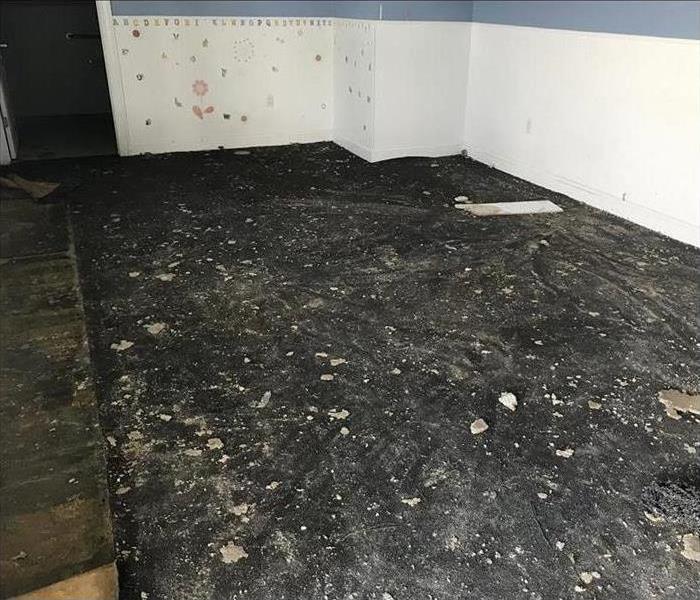 Storm damaged flooring in Manda, TX.
Storm damaged flooring in Manda, TX.
How to Make a Flood Damage Claim Following a Natural Disaster
If your home in Manda, TX, was flooded by a natural cause or disaster, it’s time to file a flood claim. This can help you get the funding you need to recover from the damage. However, filing an insurance claim can be confusing. Here are three things you can do to successfully make a claim.
1. Start the Process
The first thing you can do is notify your insurance agency of the flood. Do this as quickly as possible so that an adjuster can contact you within the next few days. You can discuss what action to take and what you should be doing on your end while you wait. Be sure to have the name of your insurance, the policy number, and your phone number ready.
2. Document Everything
Next, photograph the damage. It’s important to document everything that was damaged during the flood so that you have evidence of what losses you suffered. Take pictures and videos of your entire home. You can also make a list of damaged or lost items and use that in your flood claim. Don’t forget to place damaged items outside to prevent mold growth within the house.
3. Back Up Your Claim With a Proof of Loss
With the help of your adjuster, you can create a Proof of Loss to prove that you are claiming the correct amount of money. This contains specific details concerning the damage from the flood and must be filed within 60 days of the disaster. Once you and your insurance company agree on the amount, the claim payment should come.
Insurance can be beneficial when dealing with the water restoration process, and filing a flood claim doesn’t have to be complicated. By carefully and concisely compiling evidence and keeping in touch with your insurance company, you can file the claim and receive payment. Keep in contact with your insurance company to find out how you can best receive the help you need.
Flood Recovery: When Is It Safe to Return to Work
11/15/2021 (Permalink)
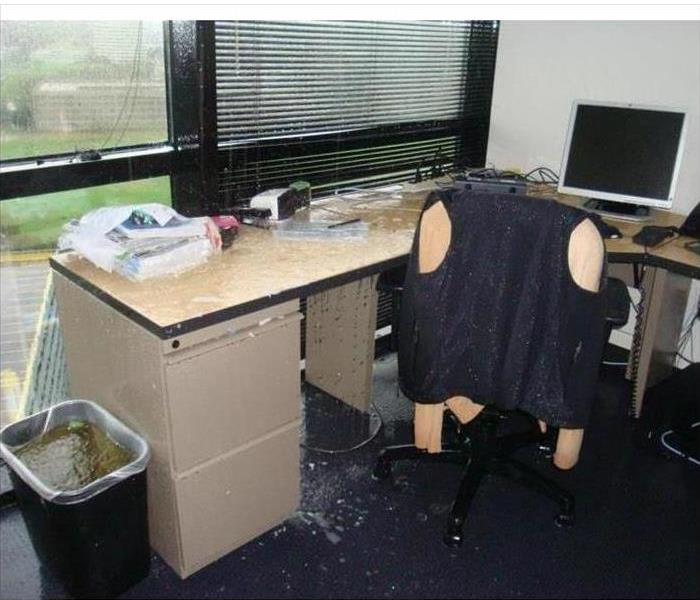 Commercial storm damage in Pflugerville, TX.
Commercial storm damage in Pflugerville, TX.
When Is It Safe to Return to Work After a Flood?
After a flood, many employees and business owners want to know when they can get back to work, but that depends on the severity of the damage and whether the flooding was caused by black water. In either case, most restoration specialists from Pflugerville, TX, follow a similar process to ensure your business returns to normal as soon as possible, but most phases are not conducive to safe operations.
1. Cleanup
During a flood cleanup, it is not wise for employees to be present because, depending on the water classification, they may become severely ill. Black or gray water is common after flooding, and it is often contaminated with chemicals and bacteria that present serious health risks to all. It is best that all personnel who are not trained or certified in disaster cleanup stay away from the facility during the initial cleanup phase.
2. Demolition
During the demolition phase, the restoration company you have hired will remove any elements that may have been contaminated by the black water. This phase will likely require the removal of carpets, drywall, insulation, other furniture, and porous items. The facility will not be conducive to regular business operations at this time, and therefore employees and personnel should stay away.
3. Sterilization
The last phase before restoration is sterilization and may be combined with the previous stages. During this phase the entire affected area is scrubbed and disinfected, ensuring a sanitary environment for the restoration efforts. As this phase encompasses the use of strong commercial and chemical cleaners, it is advisable to remain clear of the facility.
4. Restoration
During the restoration phase, the company you hired will be replacing walls, carpets and other essential elements. While it may be challenging to operate depending on the significance of the restoration, you and your employees can return to work during this phase.
As flooding can produce both gray and black water, employees and business owners should allow professionals to handle the cleanup and restoration of the property. During the initial phases of cleanup, demolition and sterilization the business should remain closed, and employees should stay clear, only returning to work when restoration begins.
How Can You Mitigate Mold Growth After a Flood?
10/19/2021 (Permalink)
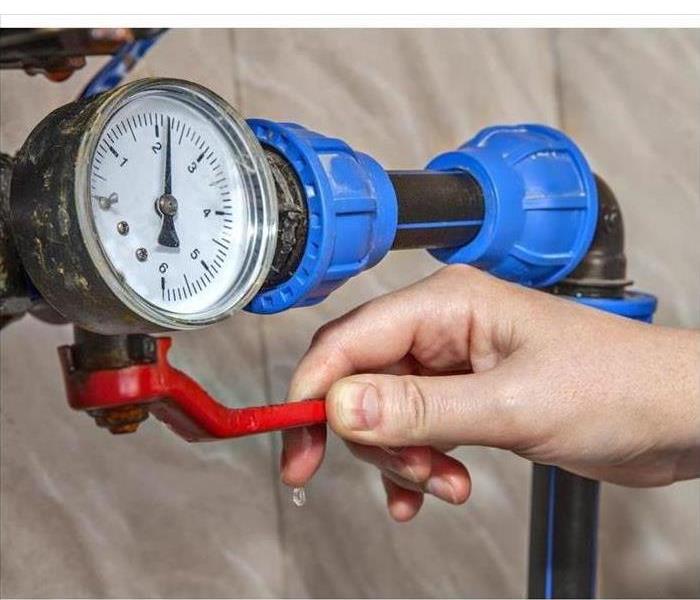 Shut-off valve before a flood occurs.
Shut-off valve before a flood occurs.
How Can You Mitigate Mold Growth After a Flood?
When a home in Pflugerville, TX, sustains any type of water damage, mold often appears soon after. Mold growth tends to spread quickly in homes, and it's often important to act quickly when it comes to mitigating the effects of mold in your home.
1. Stop the Flow of Water
Whether a major pipe burst or a minor leak is causing water damage to your home, it's often important to quickly stop the flow of water. Even small amounts of water can contribute to the spread of mold spores in your home. Since you may have to act quickly if water is pouring into your home, it can be useful to know the location of your home's water shut-off valve before a flood occurs.
2. Limit Airflow in Your Home
After your home has flooded, you likely will want to dry out your home as quickly as possible. Though it can be useful to keep your home dry after a flood, the way you do this is often important. Turning on the heat or air conditioning increases the airflow in your home, which makes it easier for mold spores to spread. Instead, consider opening windows rather than using air conditioning to help minimize the spread of mold growth in your home.
3. Contact a Mitigation and Restoration Company in a Timely Manner
Standing water in your home can act as a breeding ground for bacteria and creates the perfect environment for mold to spread. Though you may want to use DIY methods of mitigation or restoration, it's generally best to contact a mold damage mitigation and restoration company. Professionals with experience in mitigation and restoration can safely and quickly help to limit the effects of mold can help to prevent additional damage to your belongings and to the structure of your home, and can also assist in restoration efforts.
Mold growth is a major concern for homeowners, and preventing further mold damage is often important. You can help to mitigate the damage by stopping the flow of water, reducing the airflow in your home and quickly contacting a mitigation and restoration company.
In Praise of Action: Why Timely Mitigation Is Important
9/20/2021 (Permalink)
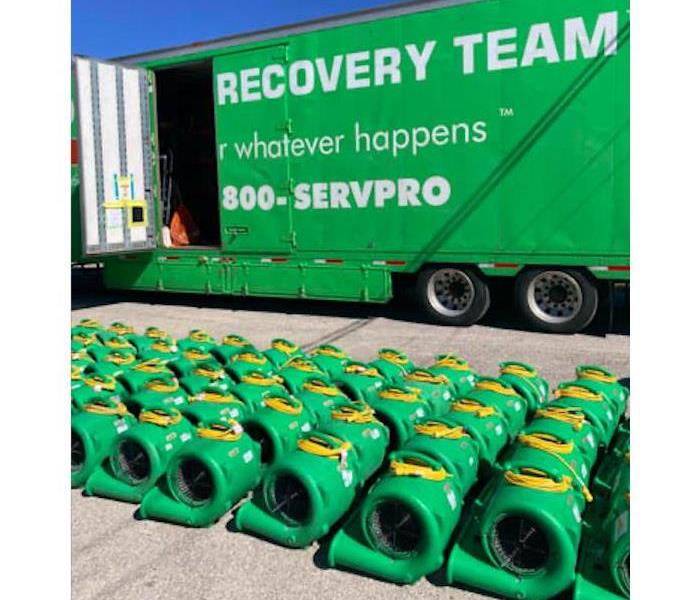 Just because you call the insurance company first doesn't mean you have to wait for them.
Just because you call the insurance company first doesn't mean you have to wait for them.
Storms can cause a great amount of damage to your home, not only on the outside but on the inside as well. When floodwaters seep in, you may end up with a lot of flood damage. If you have flood insurance, one of your first calls should be to your insurance company, but that doesn't mean you have to wait for your adjuster to arrive to start the cleanup process. On the contrary, doing so may cause more damage and hurt your chances of having your claim accepted.
Secondary Damage
Your home in Austin, TX, wasn't built to hold water. The longer you delay in cleaning up after a storm, the more damage it will continue to do. Unresolved flooding can lead to more problems:
• Further permeation of walls, floors and ceilings
• Damage to electronics
• Breakdown of varnish on furniture
• Contamination of textiles
One of the biggest problems that may not be covered by your flood insurance is mold damage. A mold problem is often preventable when you enlist mitigation services in a timely manner. It doesn't take long for mold to grow, and if you let the dampness lead to fungal infestation, your insurance adjuster is likely to see it as neglect and thus won't count it as a damage your policy covers.
Claim Preparation
The adjuster may be too busy to arrive within a few days of flooding. It is important, therefore, to document damage. Take pictures and video of the areas that need restoration. Make a list of everything that needs to be repaired or replaced and put the approximate cost of doing so beside each item. The adjuster will still walk through your home to assess the damage, but if you have pictures of what it looked like in the beginning, you don't have to wait to start cleaning up.
Just because you call the insurance company first doesn't mean you have to wait for them. Limit secondary damage and get your home restored more quickly by starting the mitigation process as soon as possible.
The Basics of Flood Mitigation vs. Flood Restoration
5/27/2021 (Permalink)
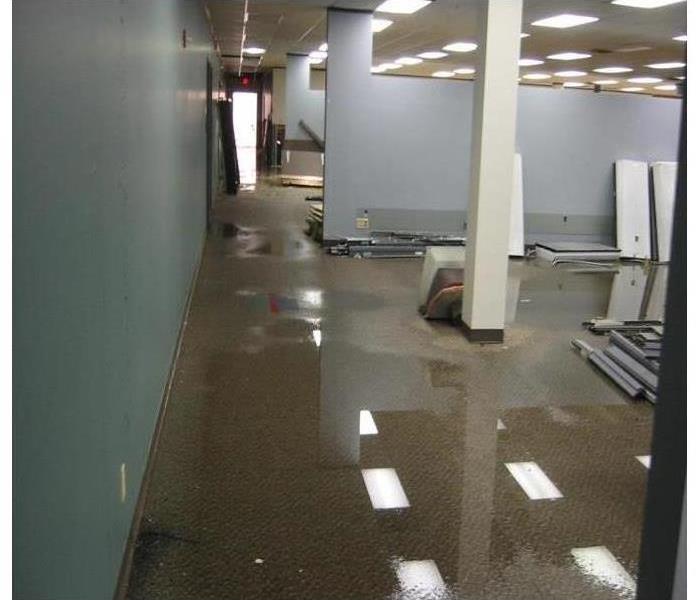 Commercial flooding in Pflugerville, TX.
Commercial flooding in Pflugerville, TX.
If your Pflugerville, TX, business is damaged by a storm or other disaster, it’s important to hire a good flood cleanup company right away. These professional crews can thoroughly clean and restore your business to get you up and running again as soon as possible.
When trying to choose the right cleanup team, you may notice that many companies offer mitigation services, restoration services, or both. Understanding the difference between mitigation and restoration will help give you a better idea of what to expect during these phases of the flood cleanup process and may help you select the right restoration company for your job.
What Is Flood Mitigation?
After a storm or flood, the first step in the cleanup process is water damage mitigation. This phase should ideally begin as soon as possible after the damage occurs and is usually a quick process. The primary purpose of the mitigation phase is to prevent any further water damage to your business. Preventing mold growth and other secondary damage is especially important during this phase. Some examples of what a flood cleanup company does during mitigation include:
- Boarding up windows and tarping over the roof to prevent further damage from rain, wind, wildlife, or looters
- Removing wet and damaged contents and materials, such as furniture and flooring, from the building
- Extracting as much water as possible from the building
- Using commercial-grade tools and equipment to thoroughly dry, clean, and disinfect the building
What Is Flood Restoration?
The mitigation process is extremely time-sensitive, with a focus on preventing new damage rather than repairing existing damage. The focus of the restoration process, by contrast, is repairing the damage to your property caused by the flood or storm. Restoration involves such tasks as repairing structural or roof damage, replacing flooring and drywall, and eradicating mold growth. Depending on the extent of the damage, the restoration phase may be lengthy.
Mitigation and restoration are two separate cleanup processes that can be done independently. However, choosing a flood cleanup company that will handle both can save you time and money.
2 Ways To Stop Your Toilet From Overflowing When You Take a Shower
1/14/2021 (Permalink)
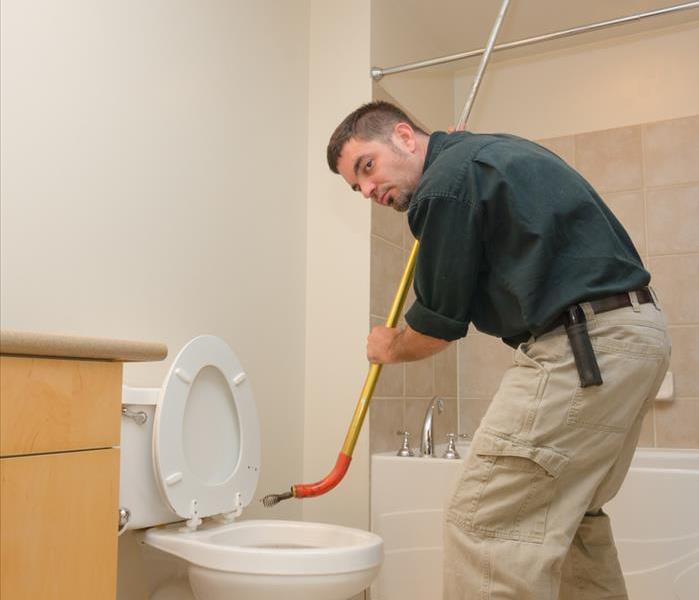 Snake the toilet
Snake the toilet
Two Methods To Prevent A Toilet Overflow When You Take a Shower
One of the last things you want to encounter when you step out of your shower is a flood caused by your toilet overflowing. This type of toilet overflow is usually caused by a clog between your sewer and your toilet. These two methods of preventing this problem can save you from having to keep performing sewage cleaning in your bathroom.
1. Snake the Toilet
An auger, or snake, is a plumbing tool used to remove debris from drains and sewer lines. The snake is a long, thick, flexible wire that can be fed through the pipes by hand or by a motor. The goal is to use the wire to force the clog out of the line or break it up into small pieces that will flow out with the wastewater. You need a snake that is at least 25 feet long for this task.
Feed the snake through the toilet or remove the toilet and feed it through the floor drain. When you think you have cleared the clog, run the shower to see if the toilet still overflows. Have some towels or old newspapers handy to absorb any water. Because of the potential for contamination, you may want to have a sewage cleaning company in Pflugerville, TX, clean and sanitize surfaces that came in contact with sewage backup.
2. Snake the Drain Cleanout
If you still have a problem after snaking the toilet, try snaking the drain cleanout. Your drain cleanout is a cap on your main drain which is usually located in the basement or crawlspace. Remove the cap with a wrench and then feed the snake through the opening. Test the toilet to see if you have resolved the problem.
If these do-it-yourself methods fail to fix your sewage cleaning problems, you may need to contact a plumber. A plumbing professional should be able to clear any clogged pipe or diagnose any other problems that may be causing your issue.
Important Differences Between Storm Damage and Flood Damage
11/16/2020 (Permalink)
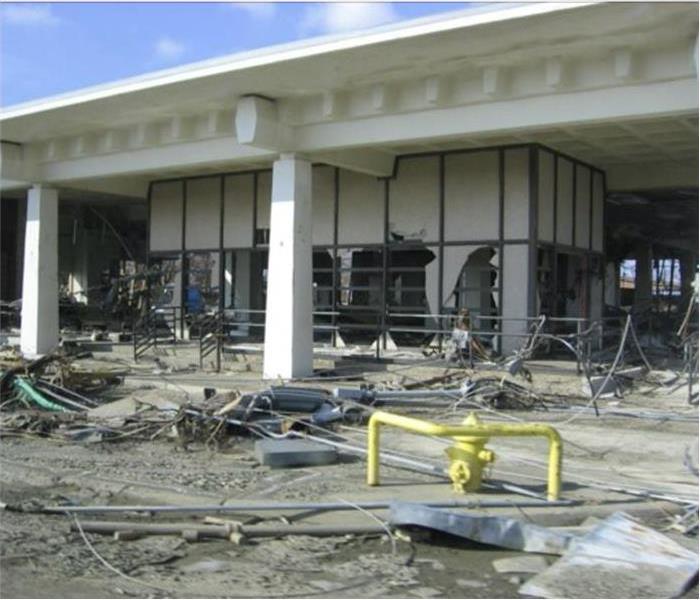 Storm damage in Pflugerville, TX
Storm damage in Pflugerville, TX
Storm Damage vs Flood Damage
At first glance, it would seem that flood damage and damage from a storm would be pretty similar. In reality, though, the two have critical differences. A flood usually occurs from the ground up, often the result of rising waters from streams and rivers and typically entering a building in Pflugerville, TX, by way of a the foundation. On the other hand, water from storms more often than not comes down from above through the roof system. Storm damage also includes harm to the building caused by powerful winds, large hail or heavy snows. Either type of damage can be devastating to a company, but the restoration process for each includes important differences.
Insurance
Flood damage is not typically covered by a company's general insurance policy, while damage from a storm is usually covered. Therefore, a company that is located in an area at risk for flooding should carry flood insurance. The most common and affordable flood insurance is available through the National Flood Insurance Program and has the following features:
- Covers damages caused by a flood
- Is administered by FEMA
- Is voluntary in most circumstances
- Is purchased through licensed insurance agents
- Typically has a 30-day waiting period
Damage from a storm is typically covered under a company's general policy. It usually covers damage caused by the storm and expenses for restoration.
Cleanup
A company faced with any type of water damage should consult with a reputable storm mitigation franchise for assistance with restoration. In the case of flood damage, though, the cleanup is complicated with the presence of contaminated water. This dirty water coming into the building could contain chemicals, pathogens, microbes and other potentially dangerous substances. This requires cleanup and restoration by an experienced team of trained technicians that wear PPE and take other safety precautions. The water from a storm coming in through the roof is seldom considered contaminated and can be addressed through a standard restoration process.
Preventing Further Damage After a Flood
9/24/2020 (Permalink)
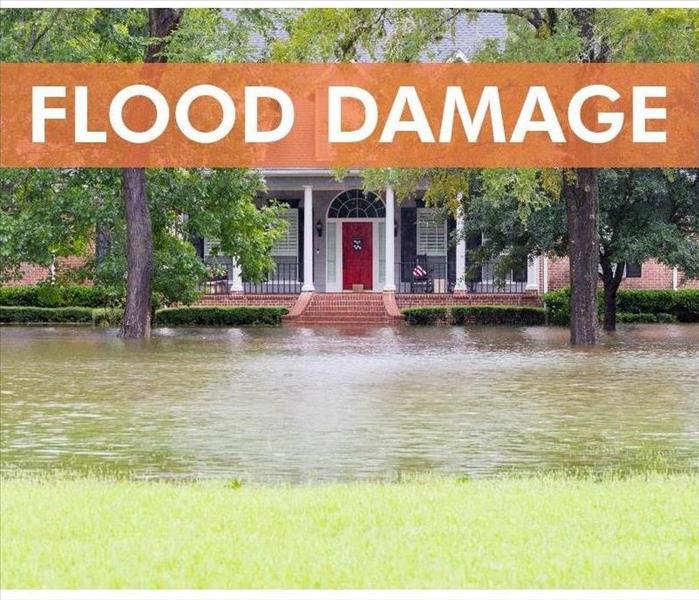 An experienced restoration service can get homes to preloss condition quickly and safely.
An experienced restoration service can get homes to preloss condition quickly and safely.
Flooding at your Austin, TX, home can cause major problems. Fortunately, flood insurance can help financially. If the flooding was widespread, you may not see an adjuster for a while. However, it is important to start the restoration process as soon as possible. The following steps outline the cleanup process:
1. Ensure safety. Floodwaters are dangerous, especially when electricity is involved. Turn off the power to your property so that you can work safely. If you cannot do this yourself, call an electrician for assistance.
2. Assess and document the damage. After local flooding, flood insurance companies will likely be very busy. This means they may not be able to send an adjuster to your property immediately. You will have to document the flood damage yourself so that you can begin the cleanup process and avoid further damage. Take photo or video evidence, being sure to capture as much detail as possible.
3. Dry the property. Making sure the property is completely dry is key to preventing further damage. Mold growth can begin within 24 hours, and water can cause permanent structural damage in certain items if left too long. Use pumps, specialized vacuums, or even buckets to remove the standing water. Then run fans and dehumidifiers to dry out the remaining water.
4. Clean and sanitize. Mold damage is not the only concern when it comes to flooding. The water itself is likely to contain bacteria and other contaminants, so it is important to properly sanitize all affected items. Fortunately, there are a variety of cleaners available, so you can choose the ones most appropriate for the items you are cleaning.
5. Repair and replace damaged items. All items that cannot be fully cleaned and dried should be thrown away to prevent further contamination. Other items may be restorable. In some cases, homeowners can do their own repairs, but delicate items often require professional restoration.
Flood insurance can financially help homeowners, but many will need assistance with the cleanup process. Fortunately, an experienced restoration service can get homes to preloss condition quickly and safely.
What Is Black Water?
9/15/2020 (Permalink)
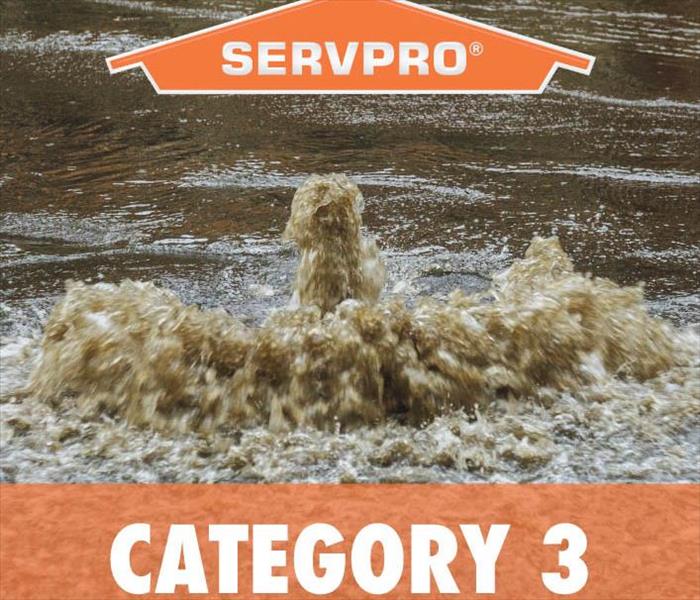 Category 3 water, also known as black water, is the most dangerous type of flooding
Category 3 water, also known as black water, is the most dangerous type of flooding
Preparation is key when it comes to protecting your commercial business from flooding, water damage and other kinds of disasters. There are several different types of floods. While all are capable of causing lethal damage, each must be handled in a specific way. Read on to learn how to protect your building in New Sweden, TX from flooding.
Types of Flood Water
There are three primary types of floods, each categorized by the types of contaminants present in the water.
Category 1: This type of flooding is categorized by a complete absence of contaminants, and are also known as clean water floods. They are often a result of a supply line pipe burst. The water in these floods is safe for human consumption, but you should still never attempt to drink it.
Category 2: Category 2 water damage is one step up from Category 1. The water present contains mild contaminants, such as runoff from a malfunctioning dishwasher or washing machine.
Category 3: Category 3 water, also known as black water, is the most dangerous type of flooding. It's categorized by the presence of biohazards, such as human fecal matter and raw sewage. Toilet backflows and sewage runoff are just a few common sources for Category 3 flooding.
Preventing a Black Water Flood
Category 3 floods are extremely dangerous and remediation should always be left to the professionals. However, you can still take the necessary precautions to prevent these types of accidents from happening in the first place. Have your main sewer line and septic tanks inspected regularly to check for damage or potential hazards. Taking proper care of the bathrooms in your building can help prevent toilet overflow as well. Hang clear notices instructing customers not to flush feminine products or other objects that could block your toilets' pipes.
While taking the necessary precautions can certainly reduce your risk of encountering Category 3 water damage, your building's safety is never a complete guarantee. If you do fall victim to black water flooding, it's vital that you contact flood remediation experts as soon as you can.
Protect Your Business During a Thunderstorm
8/13/2020 (Permalink)
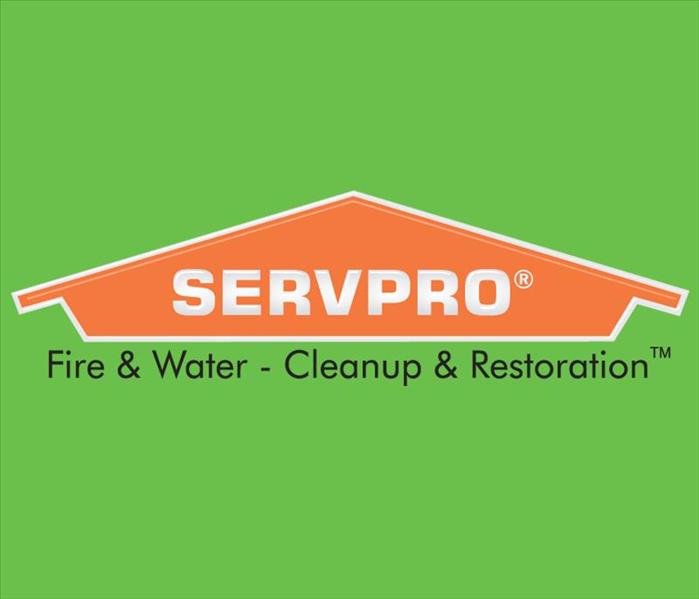 Severe rainstorms are no joke and many buildings have been devastated because they neglected to prepare properly.
Severe rainstorms are no joke and many buildings have been devastated because they neglected to prepare properly.
Thunderstorms are tricky because of how drastically they can vary in terms of severity. Mild thunderstorms are nothing more than a nuisance, while severe storms can wreck havoc on your commercial building. It's important to ensure that you're prepared for any type of rain storm, just in case. Follow these tips to keep your building in Austin, TX, safe.
Before the Storm
Preparation is key, no matter which type of emergency you're dealing with. Use the following safety checklist to see whether your building is prepared to take on high winds and other dangerous weather:
You have an emergency supply kit fully stocked and easily accessible.
You and your employees have learned and practiced proper emergency protocol.
You have designated a safe place in your building to shelter during the storm.
You have consulted your local fire department regarding proper lightning rod installation.
You have ensured that the trees and shrubbery surrounding your building are properly trimmed.
During the Storm
Assuming you have abided by the preceding and your building is adequately prepared to take on a severe rain storm, staying safe and calm during the thunderstorm should be a breeze. Simply make sure that everyone in the building stays sheltered in place for the duration of the storm. Stay tuned in to local emergency broadcasts for updates. Secure all doors and windows and shelter away from any glass paneling. Avoid using any plumbing or electrical equipment for the duration of the storm. Even if you think the storm has passed, you should still wait to leave until at least 30 minutes after the last thunder clap, or until your emergency broadcast radio gives the all clear signal.
Severe rainstorms are no joke and many buildings have been devastated because they neglected to prepare properly. Follow the above tips to help avoid letting your commercial building become another statistic. If your building does fall victim to storm damage, make sure to contact storm remediation experts as soon as you can.
6 Types of Storm Shutters That Protect Your Home
8/11/2020 (Permalink)
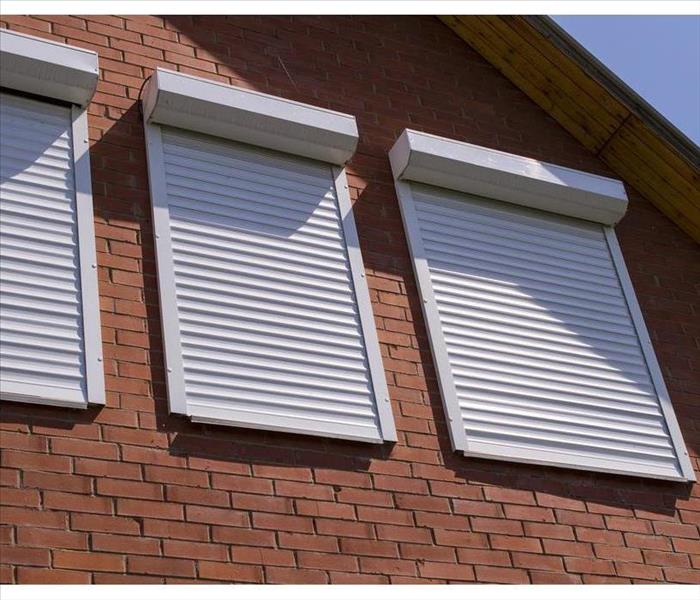 This type of shutter rolls up or down to cover the window
This type of shutter rolls up or down to cover the window
Six Types You Can Add To Your House
If you’re looking to protect your windows from high winds, you’ll want to pick a shutter that fits your budget, your home’s style, and the area’s weather. Here are the six types you can add to your house
1. Rolling
This type of shutter rolls up or down to cover the window. They’re usually polycarbonate or metal and operate by crank or hinge. They do more than protect windows; they can provide privacy and insulation.
2. Bahama
Also known as Bermuda shutters, this type of window protection connects to the top of the window with hinges and swing open like an awning. They add a decorative element to your home and are an excellent way to provide shade in warm climates.
3. Accordion
This kind of shutter is permanently attached to the side of the window. They’re often less expensive than rolling shutters, but you have to extend and fold them back manually. They’re a great choice for protecting large sliding glass windows.
4. Colonial
Colonial shutters are probably what you think of when you’re picturing window protection. They’re hung on either side of the window and are shut to cover the windows during high winds. They’re usually made of wood, and you can paint them to add a decorative accent to your home.
5. Fabric
Fabric storm panels are a more stylish (and less expensive) alternative to traditional storm coverings. They’re made from a durable mesh-like material and attach to the building with clips or grommets and straps. They’re not as strong as metal or wood coverings, but they let light through and come in a range of colors.
6. Storm Shutter
You only put storm shutters up during bad weather; they’re not permanently attached to the outside of your home. They’re usually made of metal and are one of the less expensive window protection options.
If your house in Pflugerville, TX, experiences damage from high winds, talk to your insurance company to find out repair options and costs. You may need to work with a storm restoration company to deal with any water or storm damage.
Storm Readiness
7/7/2020 (Permalink)
When storms strike, SERVPRO of Pflugerville is on standby to help assist those who need it, whether they're local or not.
As we approach the two year anniversary of Hurricane Harvey, we reflect on our involvement in the restoration process for folks in the path of that storm.
SERVPRO of Pflugerville responded to a commercial water loss in Corpus Christi, Texas. An apartment complex there suffered substantial wind and water damage, resulting in damaged roofs, and even some of the brick walls collapsing. We were able to respond the next day, and began to provide emergency water mitigation services, as well as supplemental power so that the apartments could continue to operate and care for their tenants.
It is a mission we don't take lightly, to help folks impacted by storm damage regain a sense of safety and normalcy.
SERVPRO of Pflugerville is Storm Ready
7/7/2020 (Permalink)
The one thing you can always count on about Texas weather is that it's unreliable.
This time of year, thunderstorms can develop and bring strong straight-line winds, severe lightning, large amounts of rain, and flash flooding.
Aside from watching your local weather station when inclement weather is on its way, you should also keep SERVPRO of Pflugerville's phone number handy. While we hope you don't need it, if you suffer damage to your home or business as a result of a storm, please call us to help you make it "Like it never even happened."
Along with our team of experienced and trained technicians, we are also part of a nationwide network of franchises who are ready to be mobilized and lend a helping hand, should the situation warrant it. No matter how big or small the damage is, SERVPRO of Pflugerville is equipped to restore and reconstruct it all.
Call us at 512-990-4776
The Basics of Cleaning Water Damage in a Home
4/28/2020 (Permalink)
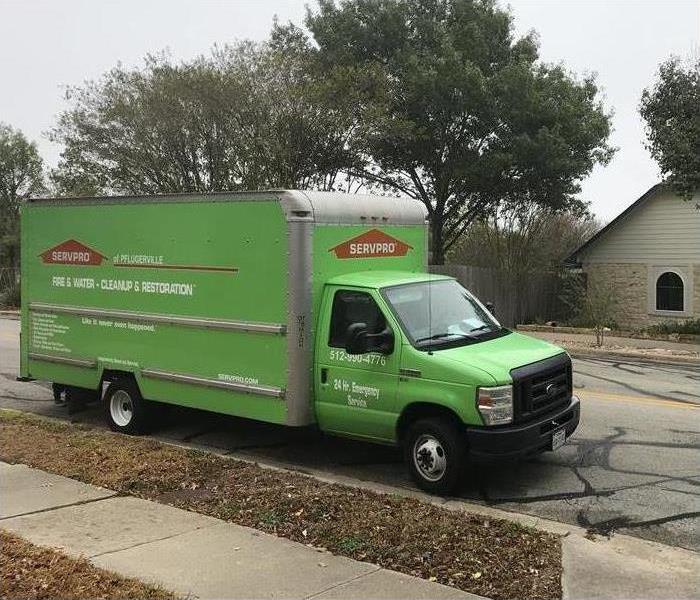 Responding to storm damage in Cele, TX
Responding to storm damage in Cele, TX
The Basics of Cleaning Water Damage in a Home
Many scenarios exist for homeowners where water leaks or floods into a residence. Some of these can be tackled in a DIY fashion, while others require the services of an expert storm remediation company. Recognizing the severity of a situation can save time and money and protect the health of you and your family members. The instances that lend themselves to DIY solutions are limited to a water source that is clean and potable, and to a problem that is small in scope. A sewer backup, on the other hand, involves a potentially dangerous water source and should be handled by technicians who wear PPE and are trained in techniques to take care of dirty water.
Big Jobs Demand Expertise
If your home in Cele, TX, is affected by a water problem, it sometimes makes more sense to call in a local team. Technicians can arrive at your home in a matter of hours and begin to assess the property. The following situations are best handled by experienced personnel:
- Sewer backup
- Broken sewer pipe
- Flooding
- Complicated job
- Toilet overflow
- Septic system malfunction
Contaminated water is present in most plumbing issues. Flood waters that enter a home might contain harmful chemicals, sewage, and animal waste. A bathtub backup is another example of dirty water escaping where it does not belong. An experienced technician will understand the techniques and equipment necessary to treat the problem.
Small Jobs Allow DIY
A small leak of clean water can be handled without calling in reinforcements. This includes situations such as the leak of drinking water or a water spill onto carpeting. The best plan is to stop the source of the leak and then to dry out any items with fans or increased ventilation. It's important to completely dry out surfaces to prevent mold from taking hold in the near future. If you suspect contaminated water is involved, such as in a sewer backup, contact a company that is Here to Help.
Flood Readiness
4/3/2020 (Permalink)
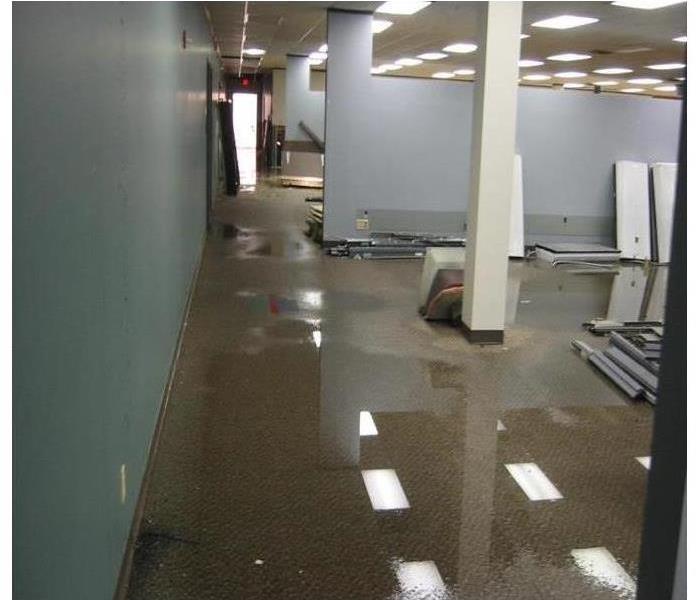 Commercial flooding in Pflugerville, TX
Commercial flooding in Pflugerville, TX
Flooding to your Pflugerville, TX business can be a very stressful event. Unfortunately, many insurance policies do not cover floods. A separate flood policy must be purchased. It is important to know the difference between flood damage and other types of storm damage so that you can make sure your commercial property is adequately protected.
Flood Definition
Many property owners think of floods as any unwanted standing water, whether from a broken appliance or a storm surge. However, according to FEMA (Federal Emergency Management Agency), to be characterized as a flood, the water damage must affect at least two acres or two separate properties and be caused by one of the following:
- Overflow of rivers, lakes and other inland bodies of water (whether due to erosion or excess rainfall)
- Tidal overflow
- Mudflow
- Surface water accumulation or runoff
Water damage caused by other means, such as a roof leak during a rainstorm, is not considered flood damage. In such cases, the claim should be filed with the standard property owner's insurance rather than on the flood policy.
Flood Mitigation
Although floods can cause serious problems, it is possible to minimize the damage to your business by taking some precautions. Use sandbags or inflatable dams to form a barrier around your building. You can fortify the barrier by securing windows and doors with plastic tarps. Move furniture, electronics and other important items to a safe location. This could be the second floor of your building or an off-site location. Keep electronic copies of important documents such as insurance policies. Make sure to have emergency supplies on hand and an emergency plan in place before flooding begins. When the water stops rising and it is safe to do so, begin drying out the property to prevent mold growth.
Unfortunately, it is impossible to prevent flood damage. If your commercial building suffers flooding, you may decide to contact a certified restoration company to help you get your business back to normal quickly and safely.
4 Ways to Prepare Your Business for a Winter Storm
1/23/2020 (Permalink)
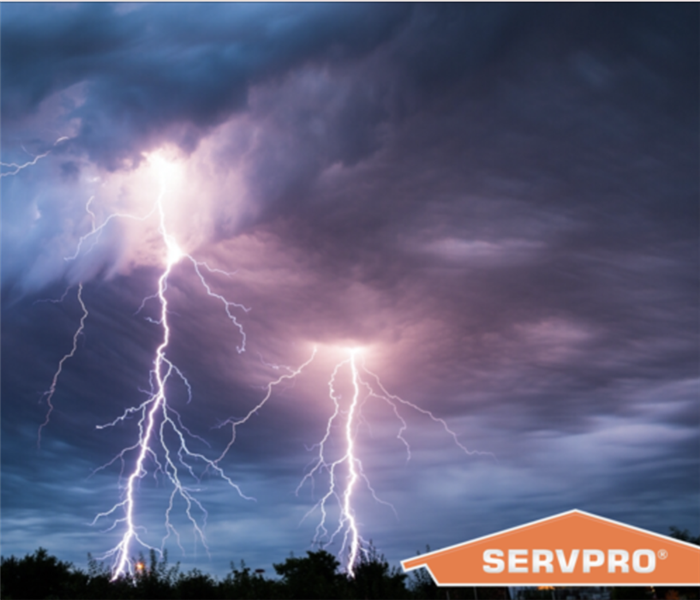 If your building is damaged during a winter storm, then a cleanup and repair company can help.
If your building is damaged during a winter storm, then a cleanup and repair company can help.
When you are expecting severe weather in Austin, TX, you should take steps to be prepared. A winter storm can cause a lot of damage to your building, so use the following tips to minimize its effect on your business.
1. Stay Informed
One of the most important things you can do to prevent storm damage is to keep updated with any new information. The weather can be unpredictable and may sometimes change quickly. Watch the news to identify any changes in the situation so you can alter your plans if necessary.
2. Keep the Building Warm
During a storm, the temperature may drop. If it gets too low, you could end up with frozen pipes which could cause a pipe break. Water may flood your building and cause damage to its structure as well as the items inside. In order to prevent this, make sure to keep the heat on even after you leave the building. You may want to insulate any exposed pipes and leave doors open to allow heat to circulate as well.
3. Check Doors and Windows
The areas around doors and windows often deteriorate more quickly than other places in the building. If these are not in good shape, they won’t be able to keep out moisture properly. Make sure that all windows and doors are sealing and well-insulated.
4. Inspect the Exterior
During a winter storm, damage to the exterior of the building can become worse. Cracks in the walls can let water in and can contribute to the growth of mold. Loose roof tiles can be blown off and leave areas exposed. Check everything carefully and have repairs done if necessary.
If your building is damaged during a winter storm, then a cleanup and repair company can help. They can remove any water that has entered the building, perform mitigation and make repairs. If any belongings have been damaged, they can salvage many of these as well.
Be Prepared for Storms
7/8/2019 (Permalink)
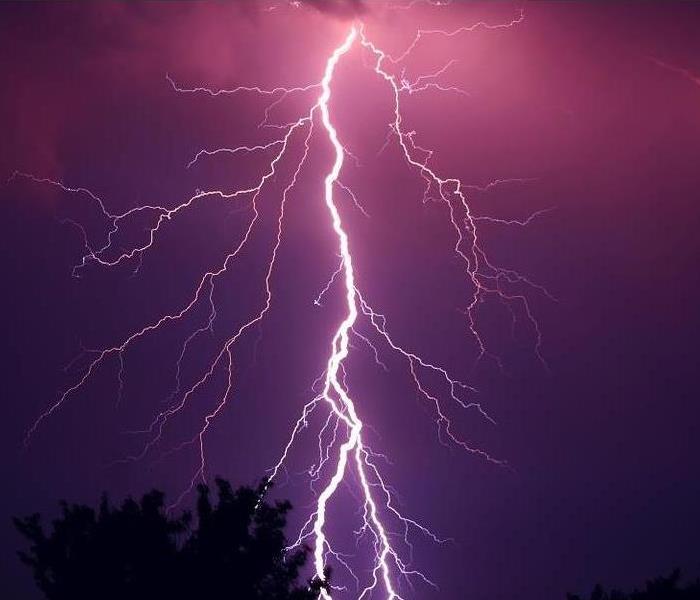 Be prepared for when storms strike.
Be prepared for when storms strike.
If you have lived in central Texas long, you are aware that the weather can be extraordinarily temperamental. Though spring is most commonly when severe weather is expected, thunderstorms can just as easily strike in summer.
While it may be difficult to prepare for the unpredictable, there are steps you can take now to help ensure that you are ready when disaster strikes.
Preparing an emergency supply kit, and storing it in a designated shelter area of your home (usually the innermost room or closet, furthest away from the exterior walls and windows) is a great way to be prepared; Add some spare batteries, along with your NOAA Weather Radio, and water enough for the members of your family. Ensure that everyone in the household knows the particulars of your emergency readiness plan, should severe storms strike.
If damage to your home should occur, SERVPRO of Pflugerville is ready to help you set it right again.
Before, During, & After a Storm
7/8/2019 (Permalink)
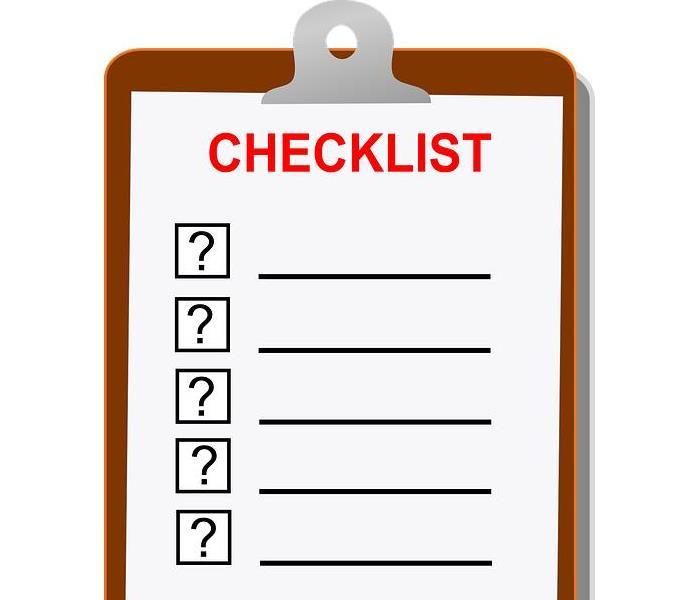 Keep these things in mind when prepping for, going through, or after a storm.
Keep these things in mind when prepping for, going through, or after a storm.
As your local restoration company, SERVPRO of Pflugerville is here to help you make storm damage "Like it never even happened."
Here are some tips for before, during, and after a storm:
BEFORE THE STORM
- Build an emergency supply kit and develop a communication plan.
- Unplug any electronic equipment before the storm arrives.
- Secure outdoor objects that could blow away or cause damage.
- If you are outdoors, get inside a building, home or hard top vehicle (not a convertible).
- Shutter windows and secure outside doors. If shutters are not available, close window blinds, shades or curtains.
DURING THE STORM
- Use your battery-operated NOAA Weather Radio for updates from local officials.
- Avoid contact with corded phones. Cordless and cellular phones are safe to use.
- Unplug appliances and other electrical items, such as computers. Power surges from lightning can cause serious damage.
- Avoid contact with electrical equipment or cords.
- Avoid contact with plumbing. Plumbing and bathroom fixtures can conduct electricity.
- Stay away from windows and doors.
AFTER THE STORM
- Never drive through a flooded roadway.
- Stay away from storm-damaged areas to keep from putting yourself at risk.
- Stay away from downed power lines and report them immediately.
Follow this advice, and heed the warnings from your local news and weather channels to keep your property and loved ones safe through to the other side of the storms.
Should you need restoration services, call SERVPRO of Pflugerville any time of day or night, and we will see to it that your property is restored properly and quickly.
When Storms or Floods hit Manda, SERVPRO is ready!
8/17/2017 (Permalink)
SERVPRO of Pflugerville specializes in storm and flood damage restoration. Our crews are highly trained and we use specialized equipment to restore your property to its pre-storm condition.
Faster Response
Since we are locally owned and operated, we are able to respond quicker with the right resources, which is extremely important. A fast response lessens the damage, limits further damage, and reduces the restoration cost.
Resources to Handle Floods and Storms
When storms hit Manda, we can scale our resources to handle a large storm or flooding disaster. We can access equipment and personnel from a network of 1,650 Franchises across the country and elite Disaster Recovery Teams that are strategically located throughout the United States.
Have Storm or Flood Damage? Call Us Today (512) 990-4776




 24/7 Emergency Service
24/7 Emergency Service
























